Australian Decimal Changeover Archives
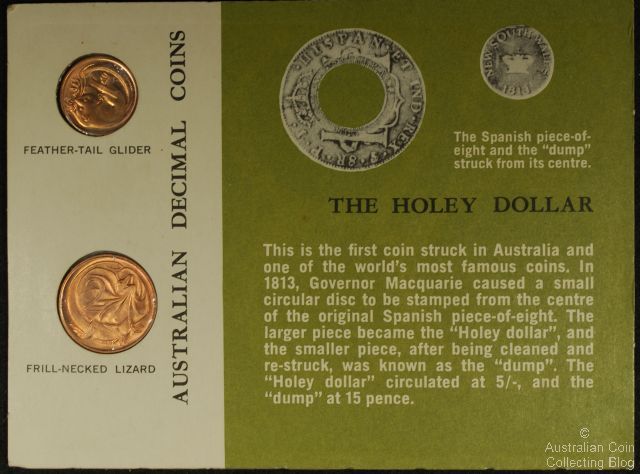
1966 1c and 2c Green card Mint Set
The 1966 green card mint set houses an example of each of the new 1c and 2c coins released at the changeover to decimal currency on February 14th 1966.
These were some of the very first new decimal coins struck by the Royal Australian Mint and were packaged for visitors to the Mint at that time. Intended for children, the green and white poly-card pack was sold for 5c each.
The Mint had wanted to charge 20c for each set as the cost of the packaging alone was 12 cents, but Treasury insisted that they were for children and the cost should be kept to a minimum. 43,100 were manufactured although it's not known how many of these sets have survived today. After bus-loads of school children visited the Canberra Mint, each spending their 5c, the RAM staff had the arduous task of cleaning up all the discarded empty packaging as the children had ripped open their packs of shiny new coins.
Today these sets sell for around $100 each (Dec 2012).
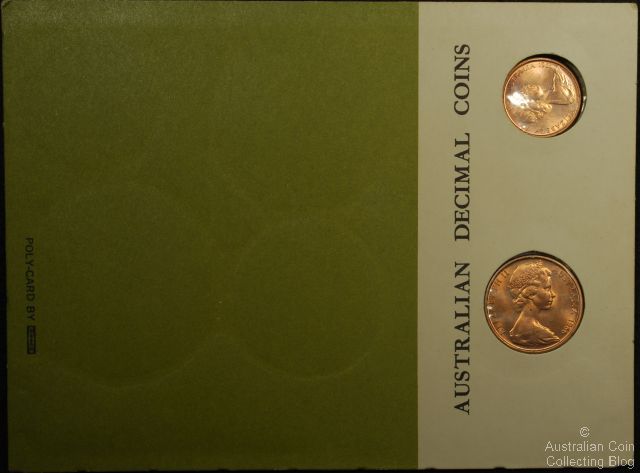
1966 1c and 2c Green card Mint Set
Reference:
Mick Vort-Ronald, "Uncirculated Decimal Coin Sets" (September 2000) Australian Coin Review
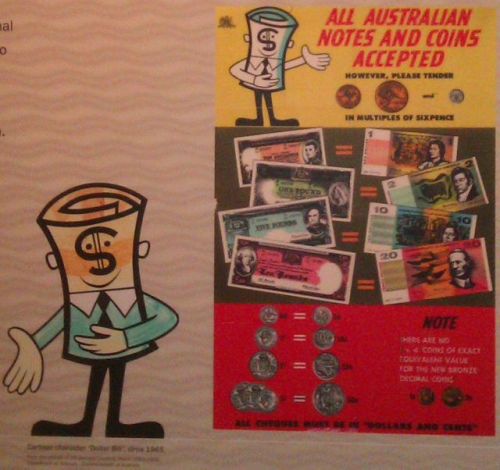
The Museum of Australian Currency Notes is located within the Reserve Bank of Australia at Martin Place in Sydney. It is a fascinating display of the history of Australia's currency notes with some stunning examples of rare notes, note designs and banking ephemera which the public can view free of charge.
The museum has an area dedicated to the changeover from pre-decimal to decimal currency in 1966. In 1963 the Australian dollar was proposed to be called the "Royal" before public opinion decided on the dollar as the new Australian unit of currency. Other proposed units were the Roo, Digger, Kwid or Dinkum. Sketches for notes in the "Royal" unit were made and these are displayed at the museum.
Dollar Bill, the cartoon character born for the changeover explained decimal currency to the general public and businesses and he adorns original posters and brochures within the displays at the museum. The Reserve Bank of Australia Museum is well worth a visit if you're travelling through Sydney.
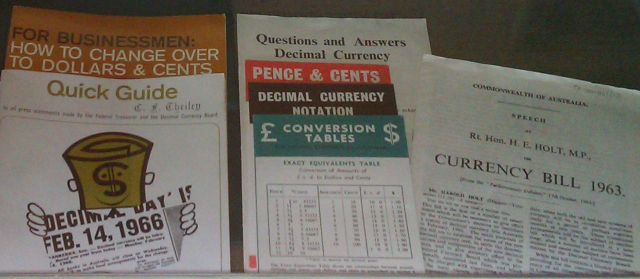
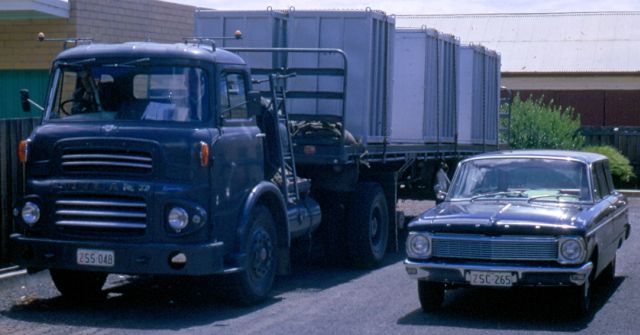
Semi-trailer Laden with Locked Containers of the New Decimal Coins and the Commonwealth Escort Car
The delivery of new coins needed at the changeover from pounds, shillings and pence to dollars and cents for February 14th 1966 was given the name "Operation Fastbuck". New coins had to be delivered to banks for the opening of business on Monday February 14th when Australia would begin a period of transition, initially with dual currency to ultimately merge full-time into the use of a new system of dollars and cents.
A lot of new coins had travelled form the Royal Mint in London and arrived at the Melbourne docks and were transported to storage at Deer Park prior to decimal changeover. Operation Fastbuck saw the delivery of all the new coins to banks Australia-wide. In the case of Victoria there were 3 groups involved in the distribution of the new coins from the Deer Park facility. Each group consisted of a semi-trailer loaded with locked containers that held the cases of coins (see image above) with the driver accompanied by an armed Federal Police Officer. A medium sized delivery van (similar to armoured Armaguard, Brinks or Chubb security vans that we see today) saw the driver accompanied by another armed police officer and 2 bank officers. A Commonwealth car (seen in image above) with driver and a police officer armed with an Owen Sub-machine gun kept guard of the semi-trailer as an escort.
On approximately 6 occasions between November 1965 and February 1966 the convoy began to distribute the new coins and banknotes. They would be gone for about 4-5 days on each occasion. After loading up from the facility in Deer Park in Melbourne the 3 groups tracked the entire state of Victoria. Each morning the security van would load money from the semi-trailer to be distributed to banks as the van criss-crossed the trucks path during the day, meeting up with the truck several times to replenish the supplies in the van. The convoy proceeded to the main roads to arranged overnight stops where the personnel stayed at local hotel/motels and the vehicles were guarded by the local police overnight. Remarkably there were no instances of robbery throughout the operation where over 600 million coins and 150 million new banknotes were distributed.
After the operation was completed a Reserve Bank function thanked the 70 or so persons involved and presented them with the very rare "Fastbuck Wallet" of uncirculated new decimal coins each in an inscribed wallet thanking them individually. The information and images provided in this entry have come from one of the Commonwealth Car drivers, Mr Charlie Browne. You can see an image of his own Fastbuck Mint Set in The Pocket Guide to Australian Coins and Banknotes by Greg McDonald (18th ed), a catalogue of Australian coin values. His recollection is that quite a few of these wallets were discarded and the new coins spent in the bar on that day of the presentation. This wallet is certainly the most collectable of all the 1966 mint sets.
Interestingly Mr Charlie Browne did not in fact work for TNT as stated in all the literature on this event. Commonly it is quoted that the 70 persons presented with these sets were TNT drivers. Possibly this is the case for other states but not in the case of Victoria where Mr Browne worked for the Government and there was no involvement of the company TNT. It was a joint collaboration between the Reserve Bank of Australia, Stores and Transport Drivers (Government heavy vehicle and Government Commonwealth Car drivers) and the Federal Police.
Thanks Charlie for your efforts during the currency conversion.
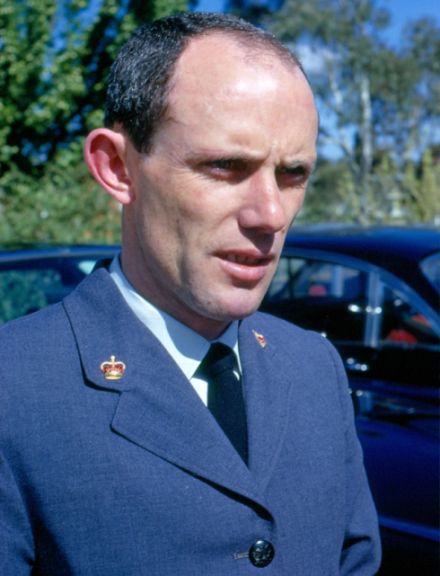
Mr Charlie Browne in 1966 as Commonwealth Car Driver
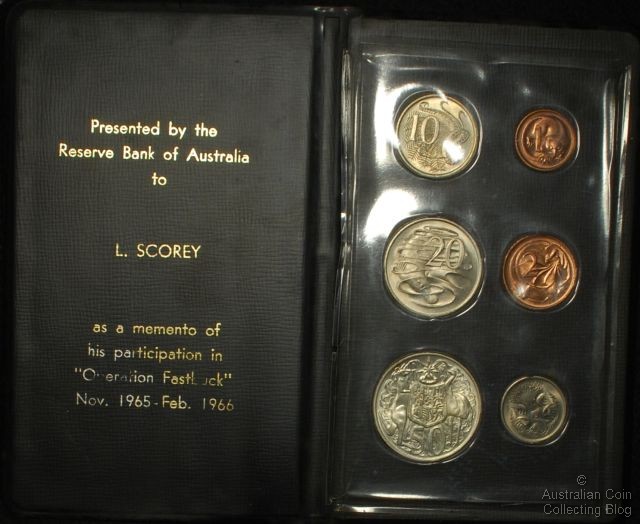
Inside the very rare Fastbuck Wallet
"Operation Fastbuck" was the name used for the safe delivery of decimal currency to the banks during the changeover from £/s/d to dollars and cents on February 14th 1966. 70 drivers were involved in the transfer of the new money in preparation for C-Day, the day Australia would start using the new currency.
These 70 drivers were presented with this special wallet embossed with their name as a thank you for their participation in the event. This is the rarest of the 1966 mint sets and is highly sought after by collectors. They very rarely come up for sale.
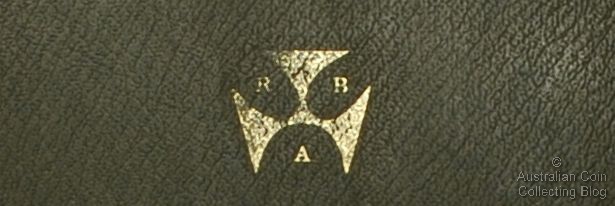
The pvc wallet is a dark green colour on the outside with the Reserve Bank of Australia (RBA) logo. Inside the 1966 uncirculated coins are housed in a hard plastic rectangular insert which is removable. The inscription on the black pvc folder reads "Presented by the Reserve Bank of Australia to L. Scorey as a memento of his participation in "Operation Fastbuck" Nov 1965- Feb 1966.
This particular wallet was issued to Les Scorey who has sinced passed away but his family have fond memories of these hard times when Mr Scorey was away from home for long periods tending to this most important event.
RIP Les, we salute your involvement in such a historical event in Australia's history.
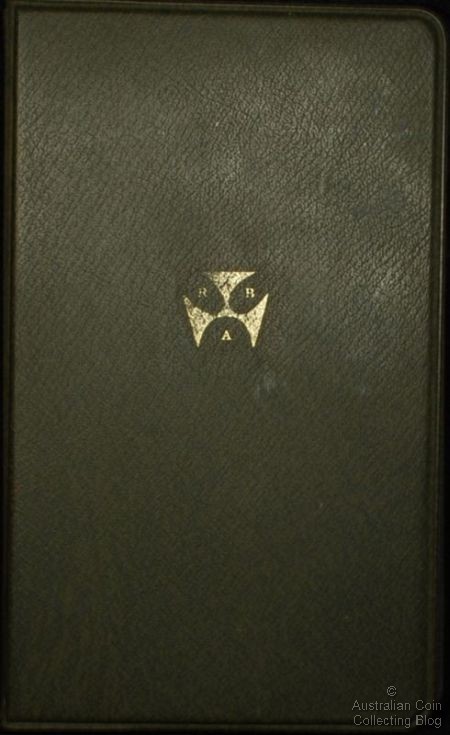
Green Cover of the very rare Fastbuck Wallet
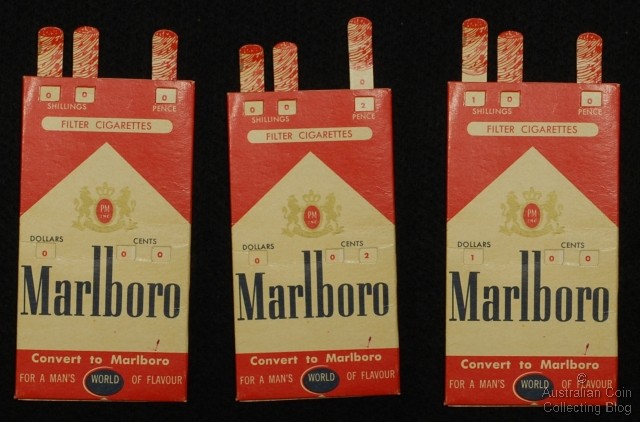
Marlboro Currency Converter
When Australia changed to decimal currency from pounds, shillings and pence on February 14th 1966 many organisations, banks and retailers distributed charts and tables to help ease the public through the transition. Changing from a £/s/d system to the decimal system was not an easy conversion as there were some denominations which did not have a direct replacement such as the half penny.
One example of the ingenuity of some of the businesses trading during the changeover is the converter seen above. Not content with a simple table to convert the total sum of your purchases made, the Marlboro tobacco company went that extra step further and this collectable is certainly a nifty little device.
Protruding the top of the cigarette packet shaped card are three movable cigarettes. Below this hidden in the packet design are numbers that magically change. As seen left above the converter sits at 0-0. Move the cigarettes up and 2 pence equals 2 cents (above middle), then 10 shillings equals one dollar (above right). How cool!
The reverse of this converter is a handy calendar of November 1965-October 1966.
disclaimer: smoking harms your health.
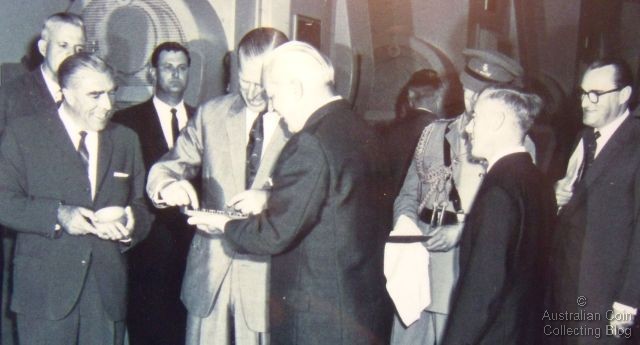
Presentation to HRH The Duke of Edinburgh at the Mint opening
The Melbourne Mint which was a branch of the Royal Mint in London produced many of the test pieces considered for decimal currency. They were struggling with pre-decimal coin production and didn't have the capacity to create the 1,000 million coins needed (for just the first year) if the country moved to decimalisation.
In 1958 cabinet agreed to establish a new Mint in Canberra to facilitate the change to decimal currency. Senior staff from the Melbourne Mint played a key role in developing the new currency and planning the new mint. In 1962 building commenced at the Deakin site at an estimated cost of £1.8 million. Another site considered was one at Camp Hill right next to the now (New) Parliament House.
The Royal Australian Mint in Deakin, ACT was first opened on February 22nd 1965 by His Royal Highness, The Prince Phillip (the Queen's husband), the Duke of Edinburgh. It was the first Australian Mint that was not a branch of the British Royal Mint. The Sydney, Melbourne and Perth Mints were all branches of the Royal Mint and were governed by the British. It was time for Australia to find it's own feet.
The new Mint allowed all facets of production to be done under the one roof, where previously this had not been possible. From pencil sketches of designs to creating master and production dies then to alloying pure metals into ingots, rolling these ingots into strips, cutting blanks from these strips and rolling the end coin product into paper to be transported to banks and retailers. The new Royal Australian Mint was at the height of techonological advancement at the time of it's opening, just prior to the decimal changeover in 1966.
Above shows the official Mint opening by HRH with the presentation of (a duplicate of) the below coin set and the wooden bowl used to catch the first coins struck at the new Mint. This photograph, coin set and bowl are on display at the First Floor Museum at the Royal Australian Mint in Denison Street, Deakin ACT.
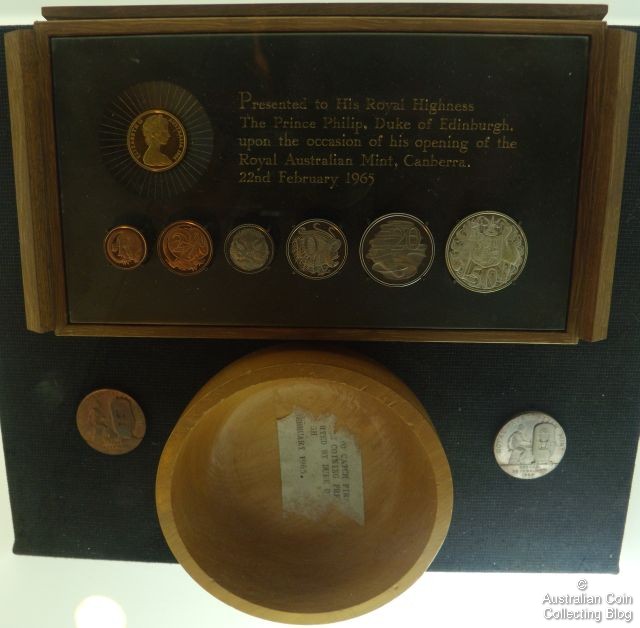
Top: Duplicate of Coin Set presented to HRH The Duke of Edinburgh in 1965 Bottom: Actual bowl used to collect the first coins produced
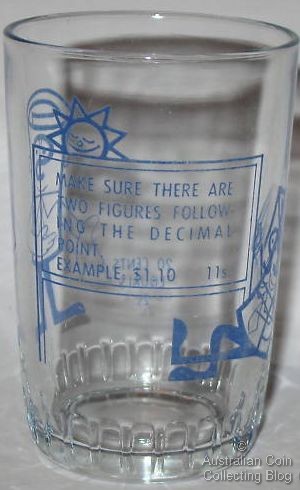
Decimal Currency Memorabilia featuring 'Dollar Bill' on a drinking glass
Decimal Changeover Day was a big day for all Australians on February 14th 1966. It was the job of the Decimal Currency Board to help ease the transition and assist everyone in coverting their pounds, shillings and pence to dollars and cents.
I've recently written an article about C-Day and how the dollars and cents were first accepted by the community.
Huge advertising campaigns and information for the public was brought in because after all, this change affected EVERYONE. It was a time for learning and making change to make life easier even if it seemed more difficult right at the start. Some of the advertising included pamphlets, books, conversion cards, charts and tables and a campaign over radio and television. One of the advertisements featuring the animated character, a so-called 'mascot' for the event, Dollar Bill can be seen on YouTube. Dollar Bill helped in a public education program through the phasing out of imperial currency over a 2 year period.
A lot of this memorabilia is quite collectable today and an interesting side collecting theme to collecting actual coins. Commemorating the occasion was also a number of medals issued including this decimal changeover medallion.
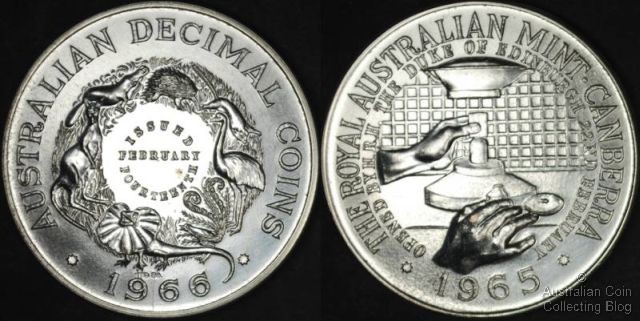
Decimal Changeover Medallion in Sterling Silver
Only at Angus and Coote Jewellers* could you buy this special commemorative medallion shown above in celebration of Australia's new decimal coins, legal tender from February 14th 1966. Released on C-day 14th February 1966 it depicts the animals used in the new currency with the obverse featuring a coin press to commemorate the opening of the Royal Australian Mint in Canberra by the Duke of Edinburgh on 22nd February 1965 in preparations for the change in currency. Available in cast bronze or sterling silver this medallion was available in a small square red leather-look/cloth/vinyl case with gilt trim (see below). The sterling silver medalllion was available at $10 and the bronze for $4.
It could also be purchased in a large square presentation case (not shown) for the cost of the medal plus $3.75 for the case. It could then be filled with the new decimal coins for face value of 88c. The long box seen below was available for $2.50 with no provision for the medal was merely a memento to house the new currrency at face value of 88c. A copy of the medal was depicted on a commemorative seal on the lid of the box.
A limited number of these 39mm medals were struck by Stokes Ltd. 6,000 bronze and 3,000 silver. The silver versions were numbered on the edge of the medal. It was also issued in 9 carat and 18 carat gold each with a mintage of 24.
Those with a Carlisle reference guide, this medal is 1966/16.
*edit: 14 February 2011 -It appears the single medal (silver and bronze) in case could also be ordered for purchase through Renniks & Co in Adelaide and Max Stern in Melbourne.
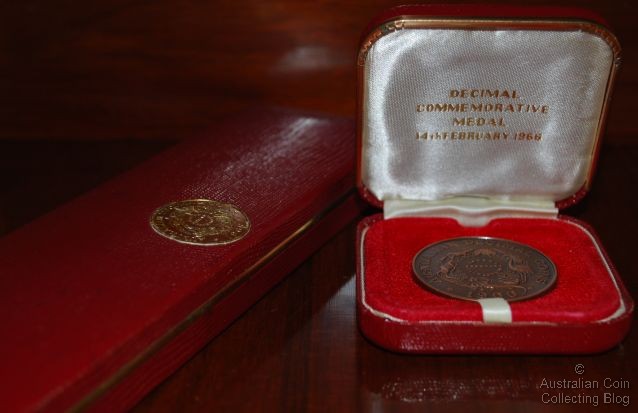
1966 Presentation Box and Medal Case with Bronze Medallion
It was excitement and deep interest as consumers deliberately spent money to obtain the new dollars and cents on C-day Monday February 14th 1966. Banks had been closed since the previous Wednesday to allow the transition to decimal accountancy and reopened for C-day to hustle and bustle.
Shops showed some confusion with shortages of dollar notes and silver coins but plenty of copper 1c and 2c, most giving change in a mixture of both pounds, shillings and pence along with dollars and cents. Under the new currency a box of matches cost 1 1/2 cents so as there was no half-cents shopkeepers wanted to sell 2 boxes for 3c. The old half-penny didn't fair in the conversion so these had been removed from shop pricing prior to the last Christmas.
Customers purchasing a middy of beer handed over 2 shillings to receive the thirst quencher and change of a sixpence and 1c. Some shopkeepers were just happy to continue trading with £.s.d and chalked the day up to "just another of Menzies' fads" referring to the Prime Minister of the time, but they would come round.
Sydney Harbour Bridge toll collectors continued to hand out shillings to disappointed drivers hoping for 10c pieces as change for their florins. The Decimal Currency Board chairman Sir Walter Scott travelled to work by train on this day watching clerks at the booking offices eyeing off the transition and it's affect on commuters "just going like clockwork this morning" he said.
The Sydney Stock Exchange transitioned easily with smooth, but slightly slower trading and investor confidence in the market appeared unaffected.
Interestingly, housewives of the time noted some price rises in household essentials in the leadup to changeover day. The conversions not always favourable so the prices just went up. An expert of the time, Professor N.R Wills (head of the School of Business Administration at the University of NSW) said the changeover would cost consumers no more than 5c (or 6d) a week extra.
"I think the advantage people will find in keeping a check on their money, and not be short-changed over the counter, will make up for this. Even morons can count up to 10".Experts said that the positives and negative pricing costs would even out and no one would be worse off for the event.
Shopkeepers who changed their pricing over on the weekend took advantage of the fractions that didn't convert well. 2 pennies converted to 2c, but so did a threepence! The drought had been blamed for fresh food increases over the past 9 months anyway increasing the cost of living by 1-2 pounds ($2-4) per week.
Back in 1966 common household items cost:
- postage stamp 4c
- newspaper 5c
- a pint of milk (600ml) 10c
- mens haircut 70c
Department stores such as David Jones and Mark Foy's (responsible for the issue of the Foy Bags contaning the 1934/5 Melbourne Centenary Florin collectors will have heard of) hired experts who were on hand to answer customer questions and staff had been training for the conversion for between 4 months to 2 years. Along with these expert staff, conversion tables and charts hung from the ceilings with charts at each register allowing customers to accurately assess their dollar and cents change. Mark Foys implemented the change with a "big dollar bargains day" with ladies swimsuits at $1.50 and cardigans for $2 to shift the idea that their prices would increase with the changeover.

Special service staff "Dollar Guides" on hand to help consumers at department store "Farmers" in Sydney


